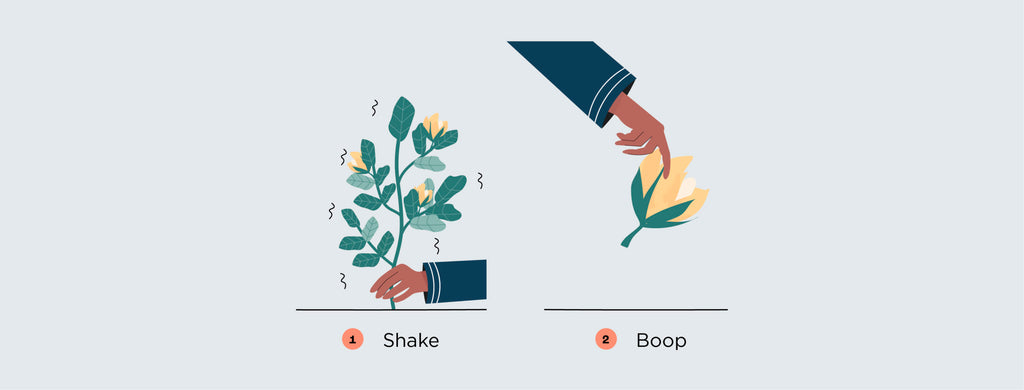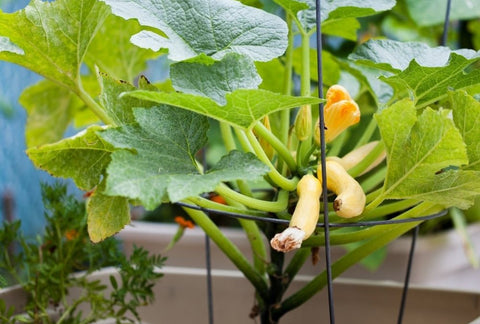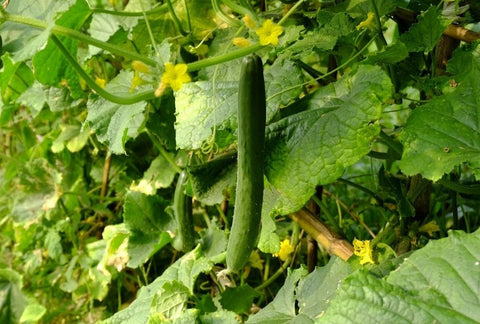Squash comes from the Native American word “askutasquash”. Virtually, the entire plant is edible, meaning, the leaves, tendrils, shoots, stems, flowers, seeds, and fruit can be eaten.

Timing
Sprouts in 1-2 weeks. Harvest from Month 3+ on.

Full sun
Equivalent of 7+ hours of direct sun [DLI of 21+ mol/m²/day].

Care
Intermediate. You’ll sprout, thin, prune, and pollinate.
Best Summer Squash Varieties to Grow Indoors
There are two types of summer squash: vine and bush types. We recommend growing only the bush types or semi-vining types indoors. Below are our top 4 favorite summer squash varieties to grow at home:
Costata Romanesco
Vine
Delicious raw or cooked. Good producer of blossoms for soups, salads, and pasta.
AmazonEarly White Bush
Bush
Has a mild, sweet flavor. Perfect for slicing and sautéing for a delicious treat!
AmazonSunburst
Bush
You can pickle, saute, grill, or even bake it with an egg inside. Super versatile variety.
AmazonBest Setup for Summer Squash Plants
You’ll need:
Planter:
Ceramic Self Watering Planter (preferred) or pot that is at least 12″ / 5 gal.
Soil:
Standard Potting Mix
Plant Food:
Herb Blend. This should be high in nitrogen (with NPK numbers like 10-5-5).
Grow Light:
A strong grow light that can give the equivalent of 7+ hours of direct sun [DLI of 21+ mol/m²/day].
Jump to: Our product recommendations
Preparing your Planter & Watering Schedule for Summer Squash
Summer Squash plants do well in moist soil conditions. If the soil dries out completely the roots will die back and it will be tough for the plant to recover. On the other hand, if the roots are exposed to standing water for too long, they can rot.
A Ceramic Self Watering Planter filled with a standard potting mix self-regulates to keep the soil at consistent moisture for your plant to thrive (and no watering guesswork for you).
To set one up:

- Fill up the planter with dry soil from the bag, gently tamping down the top.
- Dump the soil into a large mixing bowl and add water until the soil is moist, but not sopping wet (about ½ Cup).
- Mix in 1 tablespoon of the Herb Blend Plant Food.
If you are using a regular pot instead, it should be a little bit bigger (at least 12″ / 5 gal) and will need drainage holes to prevent it from being overwatered. Let the top of the soil dry out between watering.
Starting your Summer Squash: Seed vs Propagate
Summer Squash plants are best to start from seed in the area they will grow to their full size (known as “direct sowing”). They’re not practical to propagate from cuttings and they don’t handle transplanting well. Fortunately, starting from seed is simple and they sprout quickly!
How to Plant Summer Squash Seeds

Summer Squash grows quickly from seed. Plant 1 site in a 12″ / 5 gal container. In larger containers, space sites 2″ apart. For each site, plant 2 seeds 1″ deep. Keep the soil warm (70-95°F, ideally 85°F). Sprouts typically appear in 8 days but can be as quick as 6 days or as long as 10 days depending on your conditions.
Why Starting Summer Squash from Cuttings Doesn’t Make Sense
Summer Squash are short-lived plants and prone to root rot. Even under perfect conditions, they lack the genetic makeup to readily produce roots from their stems.
Where to Grow Your Summer Squash Plants
Summer Squash plants have the highest light needs of any plant – so unless you have a totally unobstructed southern facing window and plan on only growing in the summer – you’ll need a grow light. We still recommend taking advantage of your bright window (sunlight is free and great for plants!) and supplement it with a grow light. For an introduction to grow lights, head over to our post on grow lights for indoor gardeners. We’ve also got a buying guide for screw-in types, but to keep things simple in this guide, we’ll just provide directions for the 24W Screw-in Bulb by Sansi, which we think is a good middle-of-the-road option.

How Bright Should Your Grow Light Be?
Summer Squash plants need the equivalent of 7+ hours of direct sunlight [DLI of 21+ mol/m²/day] to grow their best. In order to provide an equivalent amount with a grow light, it needs to be pretty bright! The 24W Sansi bulb should be placed 6 inches away from the top of the plant. This will give your PPFD (the standard measure of brightness) of 500 μmol/m²/s.
How Many Hours Per Day Do Your Summer Squash Plants Need Under a Grow Light?
Summer Squash plants are what’s known as “day-neutral” so can grow under a range of daylight lengths. In order for them to get enough light, we recommend setting up a timer to leave it on for 14+ hours per day.
Summer Squash Plants Grow Faster in Warmer Temps
Summer Squash plants are called “warm-weather crops” and like temperatures right around 70°F. They will grow fine in conditions between 60 and 85°F but can lose their fruit if it drops below 40°F. On the other hand, if they are too hot, they will drop their blossoms, wilt, and stop ripening. Most homes are in a good range – and a south-facing sunny window can help get a plant the extra heat if needed.
Week 1-2: Check for Sprouts
You could see seedlings in as little as 6 days (though 8 days is more typical). If it’s been 10 days and you still don’t have any sprouts, it’s likely that your setup is too cold.
Week 3: Thin Your Seedlings

Thin your planter to only have 1 seedling per site – leaving the largest plant. If you are using the recommended planter (at least 12″ / 5 gal) this will mean you’ve got 1 plant after thinning. By getting rid of the smaller seedlings, you’re allowing the biggest and strongest one to flourish by reducing its competition for water, food, and space.
If your seedlings are under 2 inches, stretching out, or folding over, it’s likely that they don’t have quite enough light.
Week 4: How to Prune & Trellis Summer Squash Plants

Summer Squash plants are vines that will continue to grow and grow – so a monthly trim will be a necessary part of your care routine. You’ll make your first cut at about the second month, or when you have 5 branches and a growing tip, cut (or just pinch) off the main stem above the 5th branch. By removing the growing tip, you’re having the plant focus its energy into those 5 branches. There are several support options, ranging from cages to stakes, but we like to train those 5 branches up a fan trellis with plant clips.

After this, pruning and trellising is more of an art (fortunately an art that’s hard to mess up) but the general things you’ll want to look for are:
- Little leaves grow out of the “V” where a branch meets the main stem. Snap these “suckers” off right at their base.
- The main stem is going past your grow area. Pinch off the growth tip where you want it to stop.
- A heavy cluster of Summer Squash starts to form. The weight can snap the vine, so clip right above the cluster to the trellis to avoid this (mildly heartbreaking) event.
- The plant is getting so dense that light and air can’t get in. Keep up with interior pruning to have a tidy “bonsai” Summer Squash plant.
Month 1+: How to Pollinate Your Summer Squash Flowers

We only recommend self-pollinating Summer Squash, because it’s a bit of a pain to pollinate them otherwise (you would need to find a “male” and “female” flower that would have happened to open at the same time). Assuming you are using one of the self-pollinating varieties – wait until the flowers open then just give them a slight shake or “rub the nose” of the flower.
Month 3+: How to Harvest Summer Squashes
The rule for these is to “pick um often and pick um all.” Zucchini are at peak crispness for a short time, so you need to pick often to catch the small window of the best flavor. When vegetables start to form it’s helpful to experiment a bit to find out what they are like at peak flavor for you. If you miss a single Zucchini (and they’re good at hiding!) and it grows to maturity then these plants end their life cycle early. By preventing the plant from finishing that last step of making seeds, you are able to keep it producing vegetables for much longer.
Month 6+: End of Life
Indoor Summer Squash plants can last for up to half a year, but eventually, they’ll tire out. Once you see a big drop in productivity, in spite of giving it sufficient plant food it’s time to start over.
Shop This Blog
The right supplies can take the guesswork out of caring for your plants – and turn care from a daily to weekly routine. Through our grow tests, we’ve found these products to produce the best indoor Summer Squash (and also have simple maintenance). Plants are adaptable and can grow in many different conditions, so they are by no means necessary if you already have other supplies.
Best Containers for Summer Squash: Ceramic Self Watering Planters
Plants thrive on consistent moisture but can suffer if they’re waterlogged. A semi-porous ceramic self regulates ideal conditions. Our favorite is the COSWIP planter. Runner up is XS Self Watering Planter by Wet Pot.
Best Soil for Summer Squash: Standard Potting Mix
Summer Squash likes a rich and moist root zone – so you are best off with a standard potting mix – we like this Potting Mix by Rosy Soil.
Best Nutrients for Summer Squash: Balanced Blend followed by Herb & Lettuce Blend
Summer Squash likes nutrients that are high in nitrogen (with NPK numbers like 10-5-5). For a Herb Blend, we recommend: Joyful Dirt All Purpose
Best Light for Summer Squash: DIY or Soltech
There is a very small chance that you have the bright windows needed to grow these without a grow light. If you are looking for a higher-end option – we love the Aspect Light by Soltech. For a more affordable option, a DIY setup using a 24W Screw-in Bulb by Sansi with a Clamp Light and Timer works well too. Check out our complete guide on a DIY setup for less than $40 or our buying guide for screw-in bulbs.








There are no comments for this article. Be the first one to leave a message!